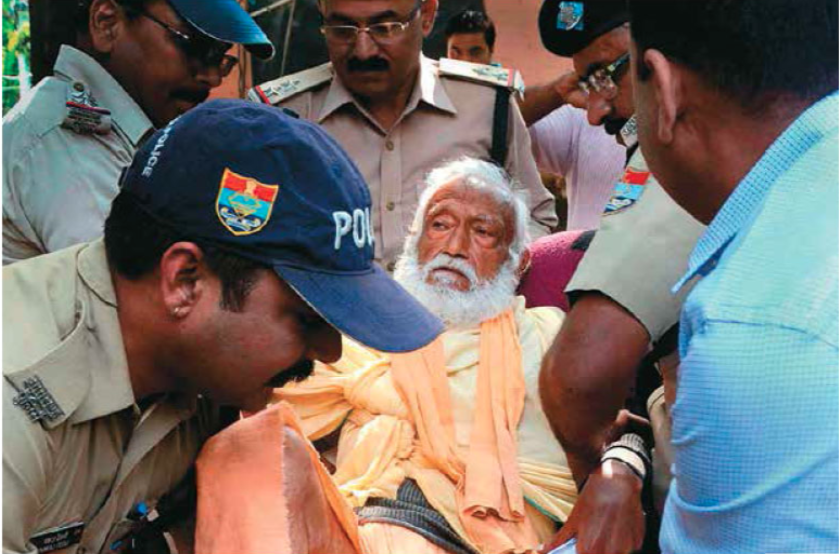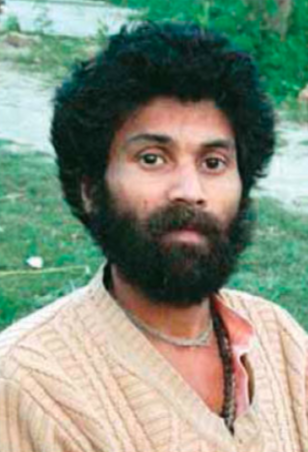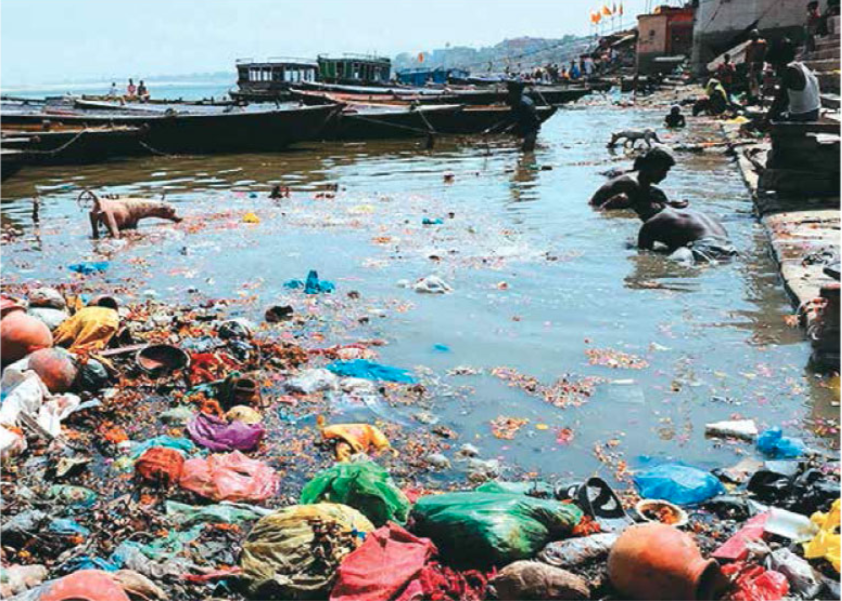In his 2014 poll campaign, Modi said ‘Ganga Mata’ had asked him to contest from Varanasi. Today, several saints have died fasting to improve the Ganga’s lot, but nothing has happened
By Sandeep Pandey
O CTOBER 11, 2018: Swami Gyan Swaroop Sanand passed away, ending his sojourn on earth on a hunger strike for cleansing the Ganga.
Former Indian Institute of Technology-Kanpur Professor Guru Das Agrawal, who became an ascetic in 2011 at the age of 79 years and came to be known as Swami Gyan Swaroop Sanand, died on the 112th day of his fast, demanding a law for the conservation of River Ganga. He left us at the All India Institute of Medical Sciences, Rishikesh.
Forty-year-old Sant Gopal Das, a Jain saint, who had fasted earlier for release of encroached grazing land for cows in Haryana, inspired by Professor Agrawal also sat on fast for the same cause two days after Professor Agrawal began his fast, on June 24, 2018, at Badridham temple in Badrinath.
At a critical health junction, Sant Gopal Das was kept in the Intensive Care Unit of AIIMS, New Delhi, after being moved about to different hospitals in Uttarakhand, Chandigarh and New Delhi. On 4 December, he was taken to Dehradun from New Delhi and left outside the office of District Magistrate. He got admitted after that to a hospital in Dehradun but is untraceable since December 6, 2018.

Twenty-six-year-old Brahmachari Atmabodhanand began his fast on 24 October as a sequel to Professor Agrawal’s fast at Matre Sadan in Haridwar, which Professor Agrawal had chosen as the site of his fast.
Even when Professor Agrawal was alive, the head of Matre Sadan, Swami Shivanand, had warned persons belonging to Rashtriya Swayamsevak Sangh, the ideological parent of ruling Bhartiya Janata Party in power both at Delhi and Dehradun, who were visiting him, that if anything happened to Swami Sanand he and his disciples would continue the unfinished task undertaken by Professor Agrawal.
BRAHMACHARI ATMABODHANAND
Professor Agrawal’s was the 59th fast by a saint associated with Matre Sadan and Atmabodhanand’s is the 60th. Brahmachari Atmabodhanand dropped out of a Computer Science graduation programme in Kerala and became a saint at the age of 21. He has fasted seven times till now for the sake of River Ganga, at least once every year since 2014.
In 2017, when he publicly protested against the DM of Haridwar, Deepak Rawat, who was patronising illegal sand mining in the Ganga, being given an award in the name of Madan Mohan Malaviya, he was beaten by the DM and his security personnel in a room behind the stage and put in jail for a day.

During the ongoing fast, Atmabodhanand was forcibly admitted to hospital by the district administration on November 29, 2018, and when his condition started deteriorating on 1 December, he left the hospital against medical advice (known as LAMA in medical parlance).
Swami Nigamanand, then 35, also associated with Matre Sadan, died on the 115th day of his fast in Haridwar demanding curbs on mining in the Ganga river
When he was in hospital, Atmabodhanand was told that he was suffering from dengue and his platelet count had dropped to 64,000, but after independently verifying it outside he discovered it to be 1,01,000.
Sixty-two-year-old old Swami Punyanand of Matre Sadan gave up food grains and is on fruit diet since Atmabodhanand started his fast on 24 October and is prepared to shift to a water diet in the event of Atmabodhanand becoming a casualty.
Earlier, Swami Nigamanand, then 35 years of age, also associated with Matre Sadan, died on the 115th day of his fast in 2011 in a government hospital in Haridwar demanding curbs on mining in Ganga, which Matre Sadan claims as a murder by a mining mafia associated with the ruling BJP in Uttarakhand then.
Swami Gokulanand, who fasted with Swami Nigamanand from 4 to 16 March 1998, a year after Matre Sadan was established, is also believed to have been murdered by the mining mafia in 2003 when he was living in anonymity at Bamaneshwar temple in Nainital.
Baba Nagnath died at Manikarnika Ghat in Varanasi in 2014 fasting for the same demand as of Professor Agrawal, to let Ganga flow uninhibited and unpolluted, Aviral and Nirmal, respectively.
Both Swami Shivanand and BrahmachariAtmabodhanand in their separate letters to the Prime Minister have quoted Śrīmad Bhāgavata to say that when Ganga becomes polluted with sins it will be the duty of saints to rid her of these sins by sacrificing their lives.
MODI AND GADKARI
But they have not content with their duty to fast for Ganga as a religious exercise. They have chosen to criticise the government, its ministers, policies and also its attitude.
Both saints have accused the PM of adopting consumerism-driven development policies which view Ganga as merely a water resource to be exploited for profits. They have reserved some harshest criticism for the Minister of Water Resources, River Basin Development and Ganga Rejuvenation, Nitin Gadkari, whose capacity for appreciating the dignity of Ganga has been doubted by Swami Shivanand.
Atmabodhanand has condemned Gadkari for having lied a day before Professor Agrawal’s death that his demands had been met. Nitin Gadkari had laid down ecological flow specifications for different stretches of the Ganga and hydroelectric projects were expected to modify their operations to ensure compliance within three years.

This was at variance with the Indian Institute of Technology Consortium recommendations and was unacceptable to Professor Agrawal which he clearly expressed in an interview just before his death. Moreover, Nitin Gadkari was vague on the question of future of hydroelectric projects and silent on mining in Ganga.
Both saints, Shivanand and Atmabodhanand, have been especially critical of corporatisation of water – the bottled water industry and the marketing of ‘holy Gangajal.’
Swami Shivanand has come down heavily on Modi for his love for foreign sojourns and attempts to make cultural city of Varanasi into Kyoto. Atmabodhanand thinks that this government is ‘nationalist’ only for namesake, otherwise it has a western view of development.
He has demanded from the PM immediate compliance of two of the four demands raised by Professor GD Agrawal – halting of ongoing and proposed hydroelectric projects on Ganga and ban on any mining in it as an expression of homage to Professor Agrawal on behalf of the country.
Atmabodhanand has criticised the government for having considered Professor Agrawal’s fast as ‘one man’s intransigence.’ He says Professor Agrawal represented the pain felt about the condition of Ganga, state of global environment, immoral development policies promoting crime and corruption and the irrational man bent upon destroying all living beings, environment and the culture of co-existence.
Atmabodhanand feels it is the arrogance of power because of which government refuses to recognise Professor Agrawal as representative of this pain felt by what he describes as ‘tradition of saints willing to sacrifice themselves for the sake of Ganga.’
Support has been received even from Bangladesh for the struggle to ensure Aviral and Nirmal Ganga, which shows the issue affects the lives of people across India’s border too.
For two reasons the hydroelectric projects are undesirable in the Himalayas. It has been seen that maximum damage was caused at the sites of hydroelectric project in the floods of 2013. Moreover, dams and barrages on Ganga, by obstructing the flow of the river, take away the unique bactericidal properties of flowing Ganga water which is present in its sediments.
In 1965 Calcutta Port Trust reported bactericides of 8.92 milligrams per litre of sediments near Sundarbans, while in 2016-17 the department of forest reports it to be 5.52 mg/l in high tide and only 4.68 mg/l in low tide according to scholar Supratim Karmakar from West Bengal.

Baba Nagnath died at Manikarnika Ghat in Varanasi in 2014, fasting for the same demand as of Professor Agrawal, to let Ganga flow uninhibited and unpolluted
A number of researchers and expert committees have opined that modern development of the kind which seeks to build hydroelectric projects is an invitation to disaster and should not be pursued. Had the government not released water from Tehri dam by submerging more people before they could be rehabilitated, there would not have been enough water in Allahabad, now renamed Prayagraj, for people to take a dip in Ganga during the ongoing Kumbh.
However, the governments have been surreptitiously promoting the dams and their builders and have ignored the sane opinion which is now resonating in the voice of the fasting saints. As the number of saints dying while fasting for the sake of Ganga keeps rising and resolve of more of them to embark on the same path becomes stronger, it may be difficult for the country and its government to ignore this phenomenon.
The BJP, now busy raking up the Ram temple issue in Ayodhya and the Sabarimala issue in Kerala, can ignore the issue of Ganga at its own peril.
If the government were sincere about cleaning Ganga, at least 4 out of 10 people in the country would have directly benefitted whereas nobody’s life is in danger if the proposed grand temple in Ayodhya is not built; and in Sabarimala the BJP is taking the society backwards by obstructing the entry
of women of child bearing age going against the Supreme Court decision.
It would have been better if the RSS-BJP combine, which leave no opportunity to exploit people’s religious sentiments, had given preference to an issue which benefits people rather than promoting a retrogressive agenda.
People haven’t forgotten that the PM claimed that he got a call from Mother Ganga to contest his parliamentary election from Varanasi. There is a high profile Rs 20,000 crore-Namami Gange project aimed at cleaning Ganga, which seems to have achieved little. Ganga has become more polluted as much water has flown through it since Narendra Modi won his election from Varanasi.
The Namami Gange programme aims at abatement of polluting activities in the river through interception, diversion and treatment of waste water flowing into it through drains.
However, the capacity of Sewage Treatment Plants is woefully short of the volume of sewage being generated and we are nowhere near being able to completely treat the whole sewage.
Rs 11,176.81 cr, which is more than half the budget of Namami Gange, has been earmarked for creating a capacity to treat 1,178.75 Million Litres per Day of sewage but National Mission for Clean Ganga, responsible for implementation of Namami Gange, estimates total sewage generation to be 2,900 MLD.
In all likelihood by the time NMCG meets its target of sewage treatment, the volume of sewage generated would have gone up several times. It almost appears to be a hopeless task. The only hope is to let the river clean itself but that will require letting the river flow naturally, a demand for which Professor GD Agrawal fasted and died and something with which Nitin Gadkari doesn’t agree.
There is a clear conflict between the development agenda of governments and the demand of environmentalists and fasting saints. There is also a view that sewage should not flow into water bodies and must find alternative disposal.
The boatfolk community, Nishad or Mallah, in Varanasi has been protesting against the introduction of cruise owned by a private company to ferry passengers. At stake is a population of about 40,000 whose livelihood depends on the 3000 boats in Ganga at Varanasi.
While licences of boatfolk have not been renewed by the Municipal Commissioner, the cruise has obtained permission from Tourism Department of Government of India.
The leader of the community Vinod Sahni is in jail on false charges since May 2018 as he was opposing the traditional exploitation of boatfolk at the hands of middlemen as well as the new projects being launched by the BJP government which are a threat to the livelihood of boatfolk.
The Nishad community is also demanding the traditional agricultural rights over land across the river from Varanasi city which is now in danger of being encroached by vested interests. People living all along Ganga, whose livelihood depends on it, face a similar bleak future.
The BJP’s hypocrisy related to Ganga stands exposed now. It is apparent that saints fasting for Ganga or the boatfolk of Varanasi matter little for it compared to the vested interests of private corporations who gain from commercialization of Ganga. If it has to choose between its core agenda of Hindutva and profits for corporations it has made its preference clear.
However, this could spell trouble for BJP. Tulsidas in Ramcharitmanas has said that if saints are unhappy in a regime then the king may burn even without fire. BJP’s fortunes have seen a sharp downhill slide since the saints started fasting in Uttarakhand, also known as Devbhumi, or land of God. It could be a mere coincidence.

Fairly insightful submit. Never thought that it was this simple after all. I had spent a great deal of my time looking for someone to explain this subject clearly and you’re the only 1 that ever did that. Kudos to you! Keep it up
Your article contains really great and helpful info. Im very satisfied that you simply shared this helpful information with us. Please keep us up to date when you create new blog. If you have some spare time, me very happy if you could skim through my blog on car history report, thank you!
Hi 🙂 I just want to mention I am just very new to weblog and certainly enjoyed you’re page. Almost certainly I’m planning to bookmark your site . You really come with terrific posts. Thanks for sharing with us your blog site.
Well , the view of the passage is totally correct ,your details is really reasonable and you guy give us valuable informative post